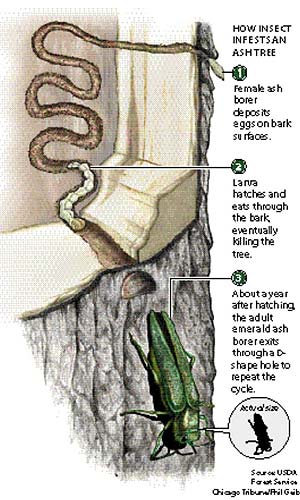Have you noticed the cutting and clearing of trees from your neighbor’s yards, local city streets, and favorite parks lately? Have you noticed the purple rectangular sticky traps hanging from trees along the roads in your hometown? It may be your local government’s response to the invasion of the Emerald Ash Borer, an insect native to Asia that has invaded the Midwest and is significantly impacting the region’s ash tree populations.
Emerald Ash Borer (Agrilus planipennis) is a dark, metallic green beetle considered invasive in North America. First discovered in Michigan in 2002, it has since been found in Ohio, Maryland, Tennessee, West Virginia, Virginia, Indiana, Illinois, Pennsylvania, Missouri, Kentucky, Iowa, Minnesota, Wisconsin, New York, Quebec, and Ontario. It spread to North America via wooden overseas shipping containers and then spread further into North America by hitching rides on contaminated trees and firewood. The larvae can travel long distances in transit on infected wood and the adults can travel short distances by flying.
The Emerald Ash Borer (EAB) attacks trees in the genus Fraxinus. It is unique in that unlike most insect pests that are specific to one species, EAB feeds on several species in the genus, including green ash (Fraxinus pennsylvanica), white ash (F. americana), and blue ash (F. quadrangulata). On average, it kills trees within three years after infestation. Adults lay eggs in crevasses in the bark and the larvae burrow into the bark where they eat the xylem (used for water transport) and phloem (used for nutrient transport) that run along the length of the tree. This activity basically girdles the tree, starving it for sustenance. Adults emerge in Spring and Summer and can sometimes be seen browsing on the leaves of the ash tree.
Ash trees are widely planted for their value as ornamentals in the U.S. and Canada. Their attractive form and resistance to disease make them popular even in areas where they aren’t native, such as the western portions of North America. They also comprise an estimated 30% of our deciduous forests in Ohio. Ash wood is used in the production of guitars for its good tone and the aesthetic quality of its grain. Each year, the United States grows 114 million board feet of ash timber, which is valued at $25.1 billion. Forty million ash trees are dead or dying at this time in the U.S alone, and the huge economic impact of the species continues to grow.
Quarantines have been used extensively in the attempt to slow the spread of EAB. In Ohio, EAB has spread to 56 counties since its original discovery near Toledo. As a result, the within-state quarantines are no longer in place. Selective cutting of ash in infested areas has also been a common strategy to eliminate small populations, although it isn’t used as often anymore. Insecticides can be effective when used in the early stages of infestation. These chemicals can be applied as injections to the soil or trunk, or as sprays to the trunk, main branches, and foliage. The use of insecticides has shown differing success rates based on the stage of infestation, size of the tree, and methods of application. In general, smaller trees tend to respond better to treatment. Biological control is also being explored with the use of parasitoid wasps that prey on the eggs and larvae of the EAB. Initial results have shown promise, and research has recently extended into the use of fungal pathogens as well. Research is ongoing in the fight against EAB with funding geared toward tracking the spread of the insect and finding ways to prevent the loss of our nation’s ash trees.
~Lauren
www.madscientistassociates.net
For more information on the spread of EAB in your area and measures you can take to protect your ash trees, visit the following websites:
The Ohio State University EAB Outreach Team
Ohio Department of Agriculture Emerald Ash Borer Program
Insecticide Options for Protecting ash Trees from Emerald Ash Borer (pdf)


